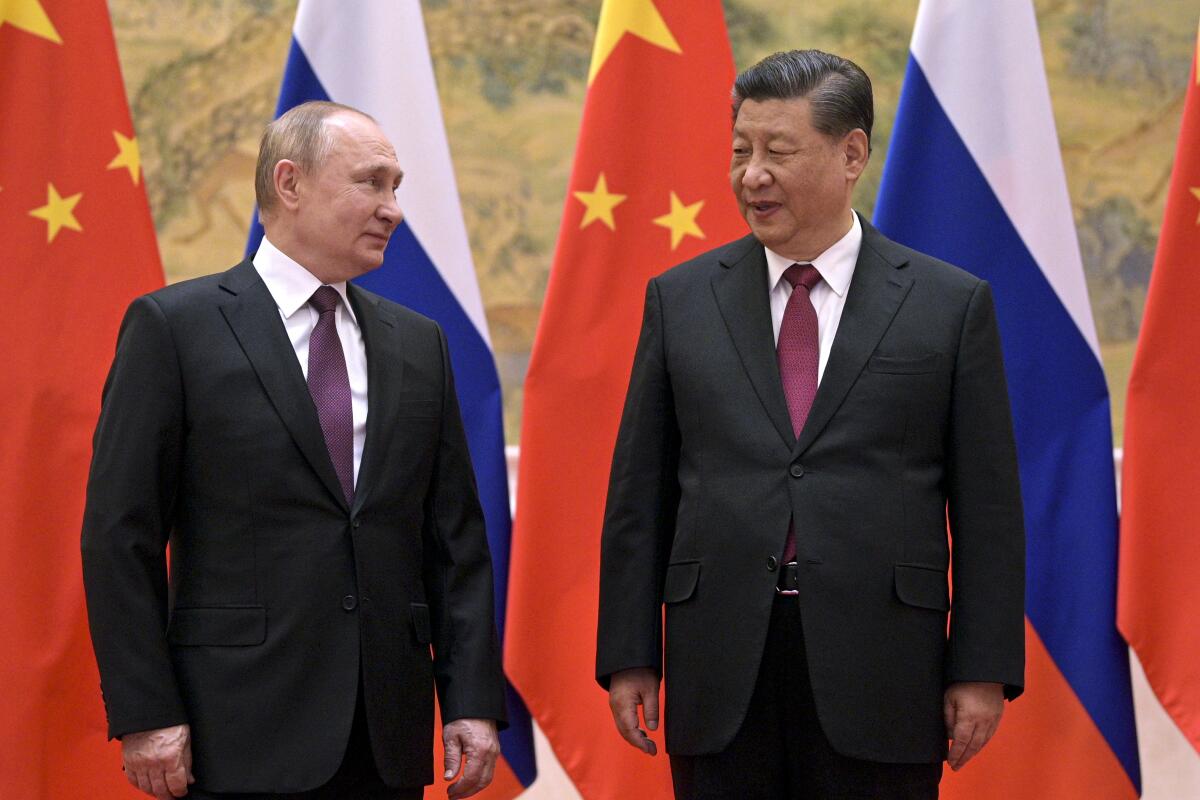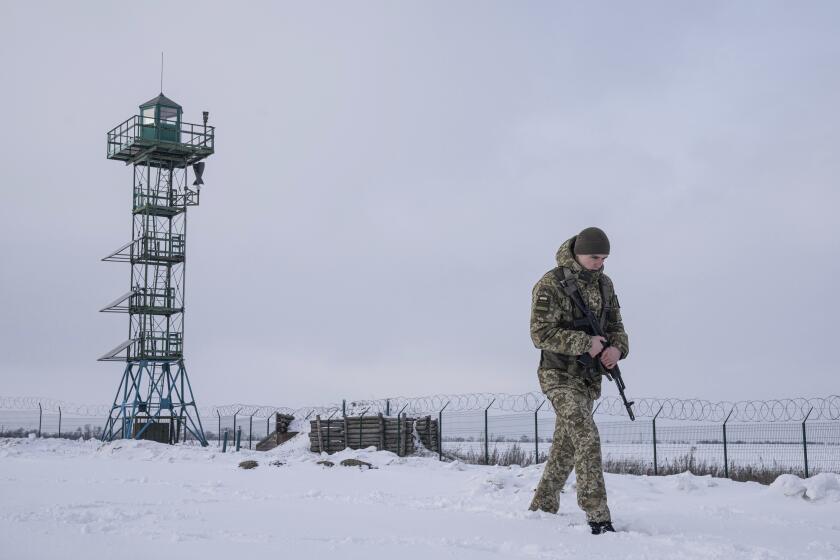If Putin wants an exit from the Ukraine crisis, the offramps are open

- Share via
WASHINGTON — When Russia’s Vladimir Putin massed 100,000 troops on Ukraine’s borders, the United States and its European allies responded with a hastily assembled assortment of carrots and sticks to deter him from an invasion.
The sticks included military aid to Ukraine, troop deployments to Poland and other countries bordering Russia and surprisingly credible warnings that military action would trigger crippling economic sanctions.
“Putin has united the West behind U.S. leadership,” Ed Luce wrote in London’s Financial Times last week. “It has been years since that sentence could be written with a straight face.”
Even without firing a shot or moving a single soldier into Ukraine, Putin is able to achieve many of the goals that an invasion of the neighboring country could also, presumably, achieve. In fact, Putin may not need to invade at all.
The carrots have taken longer.
Diplomats are scrambling to devise what they call “offramps” — arrangements both sides can live with that would make it easier for Putin to change course.
Two weeks ago, Putin was demanding quick acceptance of his demands, and U.S. officials were warning that an invasion appeared imminent. Last week, the Russian leader abruptly shifted his tone and said there was still time to find a diplomatic solution.
It isn’t clear what changed. But one factor may be that potential offramps have come into view.
Putin insists that Ukraine, once part of Moscow’s empire, cannot be allowed to join the North Atlantic Treaty Organization, which he views as an anti-Russian alliance.
As a practical matter, Ukraine isn’t going to be offered NATO membership any time soon. The alliance admits a new country only if all members — currently 30 — agree, and in this case, they don’t.
“The likelihood that Ukraine is going to join NATO in the near term is not very likely,” President Biden said last month. “So there is room to work if [Putin] wants to do that.”
The problem is that in 2008, at the urging of then-President George W. Bush, NATO promised Ukraine membership some day. Biden and other leaders from the alliance have refused to revoke that promise because that would effectively concede Putin a veto over NATO decisions.
One solution, former diplomats suggest, would be for Ukrainian President Volodymyr Zelensky to voluntarily postpone Ukraine’s membership bid.
“The cleanest solution would be for Zelensky to delay Ukraine’s application — to say, for example, that it won’t happen while he’s president,” Douglas Lute, a former NATO ambassador to Ukraine, told me last week. “He could say, ‘We still intend to join NATO some day; it’s just not in the cards now.’ But Putin will have to offer him something in return.”
Sen. Richard J. Durbin of Illinois, the second-ranking Senate Democrat, floated a similar idea.
“If [Zelensky] decides that future [NATO] membership … and the question of Russian occupation of Ukraine are two things to put on the table, I think we may move toward a solution,” he said last week on NBC’s “Meet the Press.”
No pressure, Durbin added: “It’s his decision entirely.”
That could be politically unpopular for Zelensky. Thanks partly to Putin’s threats, Ukrainians increasingly support NATO membership; one recent poll found almost 60% in favor.
One other player could solve this problem: Putin. Nothing would stop the Russian president from eliciting private promises from individual NATO leaders that they will not allow Ukraine to join the alliance. France, Germany and Hungary have all opposed Ukrainian membership in the past.
“That would be one way to solve the problem, if Putin wants an exit,” said Steven Pifer, a former U.S. ambassador to Ukraine.
But Putin has asked much more from the West than merely blocking Ukraine’s application for NATO membership. In a sweeping list of demands in December, he said he wanted commitments that NATO would withdraw its troops and military hardware from the 14 countries that joined the alliance after 1997 — meaning all of Eastern Europe. He also asked that the United States remove its remaining nuclear weapons from the continent.
In effect, he demanded that NATO agree to shrink itself, undo two decades of expansion and dismantle much of Europe’s current security architecture.
The effect was the opposite of what Putin wanted. NATO immediately bolstered its forces in the east, including the former Soviet republics of Estonia, Latvia and Lithuania. Biden dispatched 3,000 U.S. troops to Poland, Romania and Germany. Britain sent troops to Estonia; Canada to Latvia; France and Italy to Romania.
All of which, paradoxically, could make negotiating easier, not harder. Now Russia faces more NATO troops near its borders. If Putin is willing to enter negotiations to limit troops on both sides, the U.S. and its allies are too.
Another of Putin’s concerns should also be easy to negotiate. The Russian president has long complained about U.S.-made Aegis missile launchers in Eastern Europe. The United States says the missile bases are purely defensive; Putin charges that they could put TLAM cruise missiles, a sophisticated offensive weapon, within minutes of Moscow.
The solution, Lute said, is straightforward: missile inspection agreements on both sides of the border.
“We have no intention of putting TLAM there,” he said. “We’d be giving away something we don’t want.”
Which offramps might Putin consider? That depends on a more basic question: What does Putin really want?
Perhaps his new enthusiasm for diplomacy last week meant Putin isn’t bent on war after all.
Or else he merely needs more time to move military units into place. Or he’s decided to wait until Feb. 20, the end of the Winter Olympics, to avoid offending China’s Xi Jinping. Or he’s simply decided to negotiate to find out what price he can command for standing down.
In any case, the problem isn’t a shortage of available offramps. The exits are there. It’s up to Putin to use them.
More to Read
Get the L.A. Times Politics newsletter
Deeply reported insights into legislation, politics and policy from Sacramento, Washington and beyond. In your inbox twice per week.
You may occasionally receive promotional content from the Los Angeles Times.












